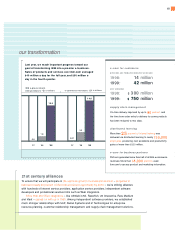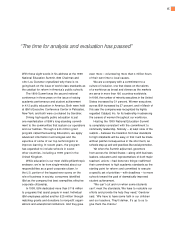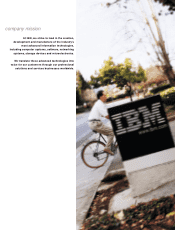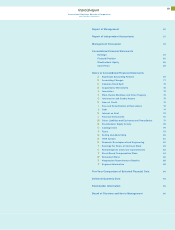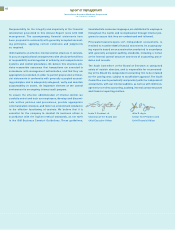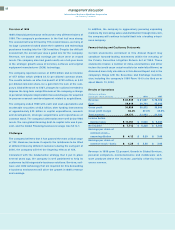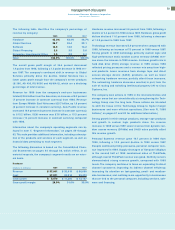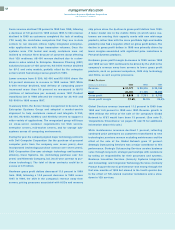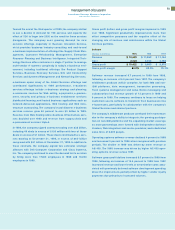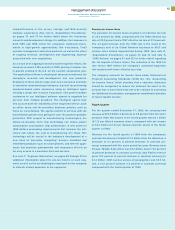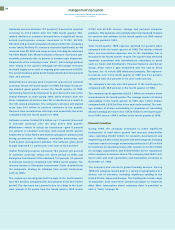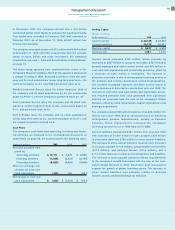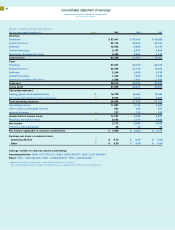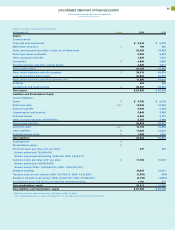IBM 1999 Annual Report Download - page 57
Download and view the complete annual report
Please find page 57 of the 1999 IBM annual report below. You can navigate through the pages in the report by either clicking on the pages listed below, or by using the keyword search tool below to find specific information within the annual report.
management discussion
International Business Machines Corporation
and Subsidiary Companies
Toward the end of the third quarter of 1999, the company started
to see a decline in demand for Y2Kservices and expects the
effect of Y2Kto linger into 2000 as the need for those services
disappears. The company sees growing demand for new
services offerings especially in Business Innovation Services,
which provides business/ industry consulting and end-to-end
e-business implementation of offerings like Supply Chain Man-
agement, Customer Relationship Management, Enterprise
Resource Planning and Business Intelligence. Integrated Tech-
nology Services offers customers a single IT partner to manage
multi-vendor IT systems complexity in today’s e-business envi-
ronment, includ
ing traditional offerings like Product Support
Services, Business Recovery
Services, Site and Connectivity
Services and Systems Management and Networking Services.
e-business spans many of the Global Services offerings and
contributed significantly to 1999 performance. e-business
services offerings include: e-business strategy and planning;
e-commerce services for Web selling, e-payments, e-procure-
ment, security and privacy; e-business enablement services;
distributed learning; and hosted business applications such as
network-delivered applications, Web hosting and Web infra-
structure outsourcing. The company’s total discrete e-business
services revenue grew 60 percent to over $3 billion in 1999.
Revenue from Web hosting and e-business infrastructure serv-
ices doubled over 1998 and revenue from supply chain and
e-procurement services tripled.
In 1999, the company signed contracts totaling over $38 billion,
including 46 deals in excess of $100 million with four of those
deals in excess of $1 billion. These deals contributed to a serv-
ices backlog at December 31, 1999, in excess of $60 billion
compared with $51 billion at December 31, 1998. In addition to
these contracts, the company signed two extensive strategic
alliances with Dell Computer Corporation and Cisco Systems,
Inc. The company continued to meet the demand for its services
by hiring more than 17,000 employees in 1999 and 18,000
employees in 1998.
Gross profit dollars and gross profit margins improved in 1999
over 1998. Significant productivity improvements more than
offset competitive pressures and the negative effect of the
changing mix of services and maintenance within the Global
Services portfolio.
Software
(Dollars in millions) 1999 1998 1997
Revenue $«12,662 $«11,863 $«11,164
Cost 2,240 2,260 2,785
Gross profit $«10,422 $«÷9,603 $«««8,379
Gross profit margin 82.3% 80.9% 75.1%
Software revenue increased 6.7 percent in 1999 from 1998,
following an increase of 6.3 percent from 1997. The company’s
middleware products (which comprise, for both IBM and non-
IBM platforms, data management, transaction processing,
Tivoli systems management and Lotus Notes messaging and
collaboration) had revenue growth of 12 percent in 1999 and
9 percent in 1998. The company continues to focus on helping
customers use its software to transform their businesses into
e-businesses, particularly in collaboration with the company’s
Global Services and channel partners.
The company’s middleware products continued their momentum
due to the company’s ability to integrate; the growing participa-
tion on non-IBM platforms and the expanding market coverage
as more partnerships were formed with Independent Software
Vendors, Web integrators and service providers; and a dedicated
sales force of 6,600 people.
Operating systems software revenue declined 4 percent in 1999
and increased 3 percent in 1998 when compared with previous
periods. The decline in 1999 was driven by lower revenue in
AS/ 400. The 1998 increase was driven by higher AS/ 400 oper-
ating systems revenue versus 1997.
Software gross profit dollars increased 8.5 percent in 1999 from
1998, following an increase of 14.6 percent in 1998 from 1997.
Increased revenue and lower levels of amortization costs asso-
ciated with previously deferred software development spending
drove the improvement, partially offset by higher vendor royalty
payments due primarily to increased volumes.
55


